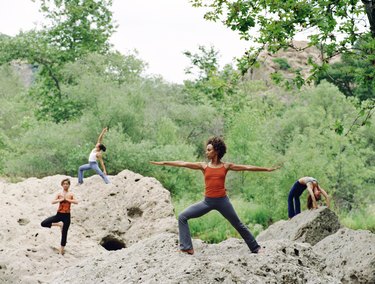
The meniscus is a C-shaped piece of cartilage located between your shinbone and thighbone. Each knee has two menisci. A torn meniscus may cause pain, swelling and stiffness. If certain yoga poses are performed without proper alignment, your meniscus is at risk for injury. Specific poses, meanwhile, may speed up the healing process after you suffer a torn meniscus. Before starting a new exercise program, consult your doctor first.
Virasana
Video of the Day
Virasana, or hero pose, is a kneeling posture with your buttocks positioned on the floor between your heels. This pose can take months or years to get into safely. To avoid tearing the meniscus in virasana, take your time mastering it. Use yoga props such as blocks or bolsters to help you. Align your thighbones so that they are parallel to each other and be cautious about rolling your knees inward. If you are recovering from a meniscus tear, avoid practicing virasana until you are fully recovered.
Video of the Day
Lotus Pose
Lotus pose is a seated cross-legged position in which your feet are on top of opposite thighs. If you don't have the necessary flexibility in the hips, the proper position of the tailbone cannot be achieved, which will result in too much pressure on the menisci. Take your time learning this pose and back off if you feel pressure or pain in the knees.
Standing Poses
Standing poses in yoga that are performed with one or both of the knees bent can strengthen the areas surrounding the menisci. Lunge positions where the knee is bent halfway and aligned with the ankle will reinforce the cartilage, ligaments and tendons around the knee. Practice Virabhadrasana II, or Warrior II pose, regularly, especially if you are recovering from a meniscus tear.
Tips and Considerations
Be gentle with your body if you're recovering from a meniscus tear. Practice gentler forms of yoga and ease back into more challenging styles. Practice under the guidance of an experienced teacher and consult your teacher on alignment specifics as you return to more advanced poses. Also, consider incorporating swimming, which is gentle on the joints, into your recovery regimen.
Is this an emergency? If you are experiencing serious medical symptoms, please see the National Library of Medicine’s list of signs you need emergency medical attention or call 911.